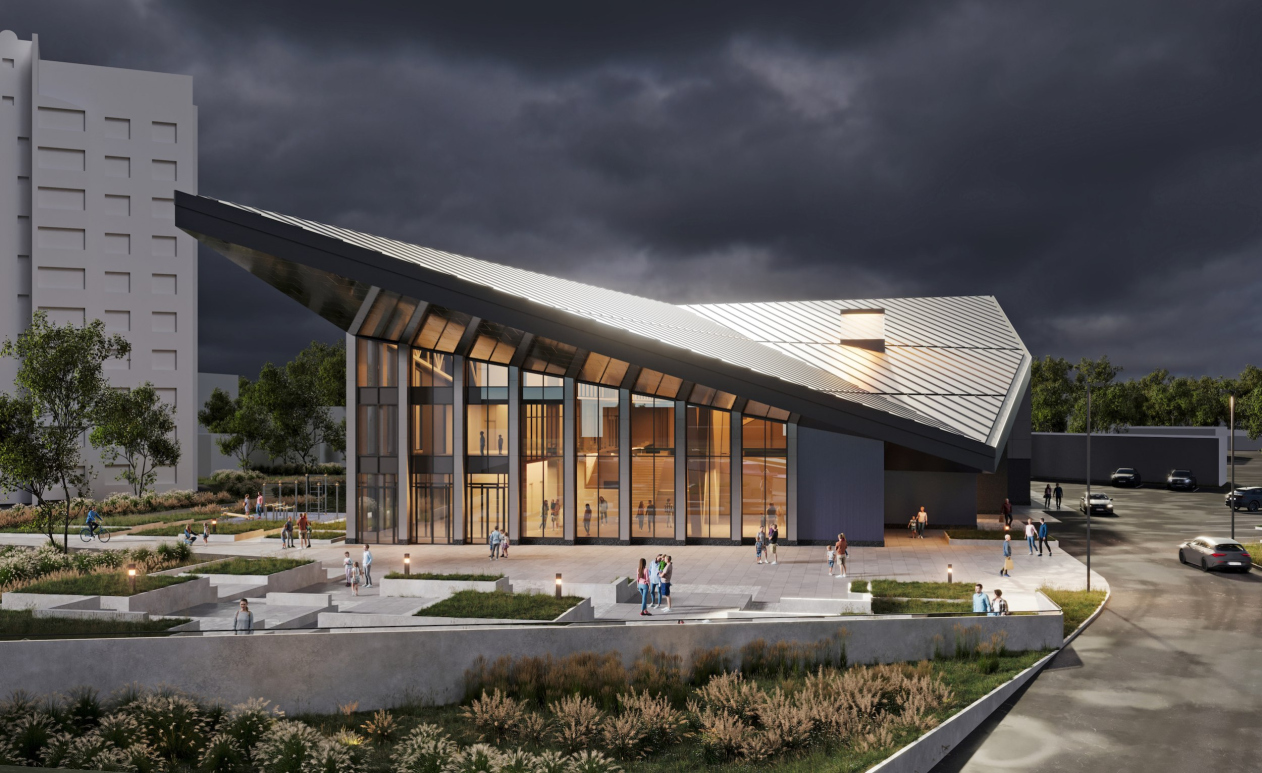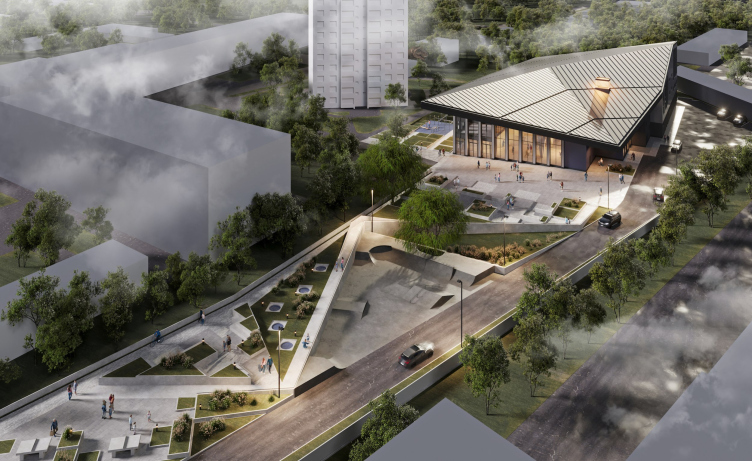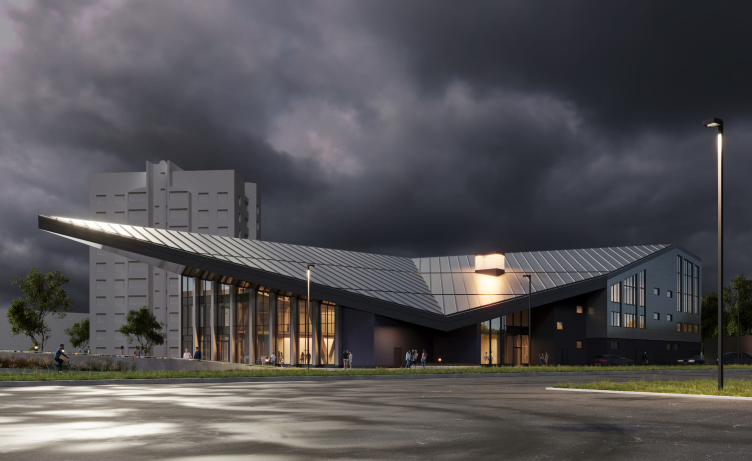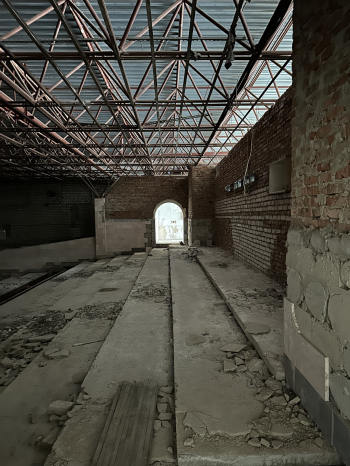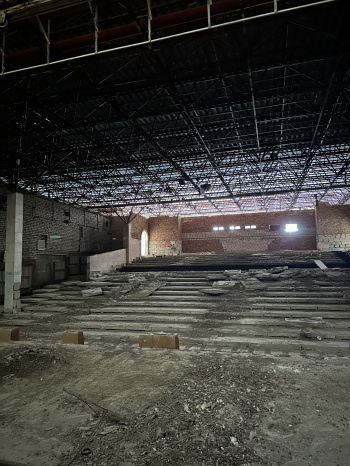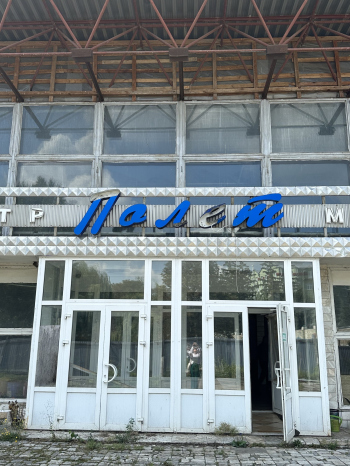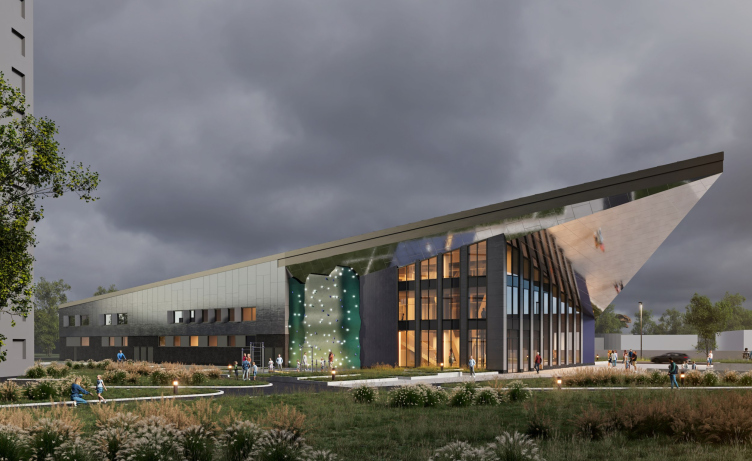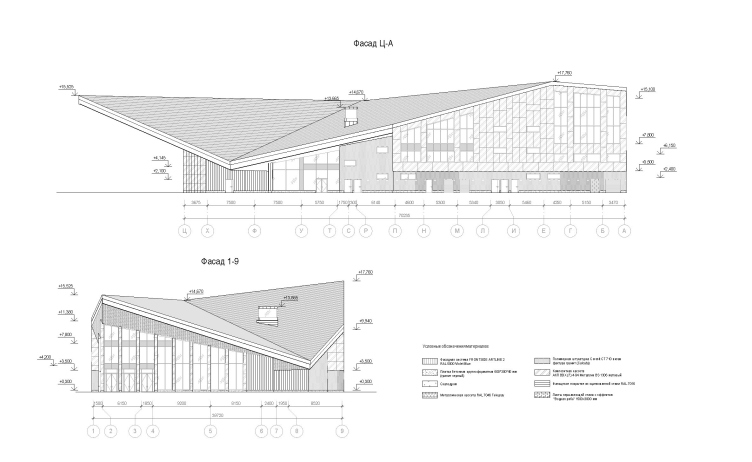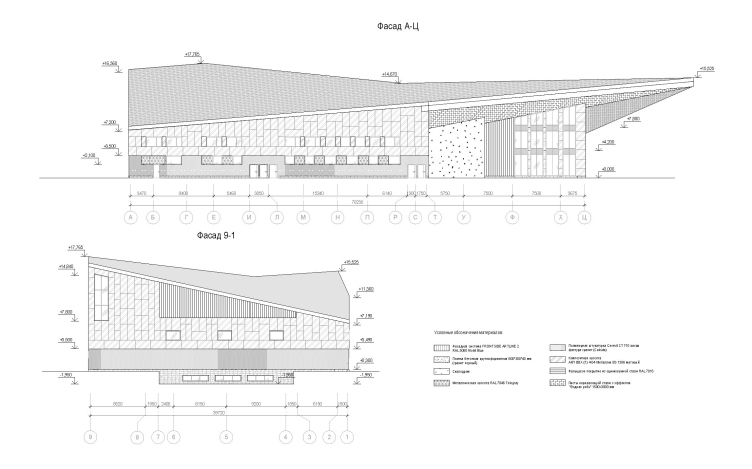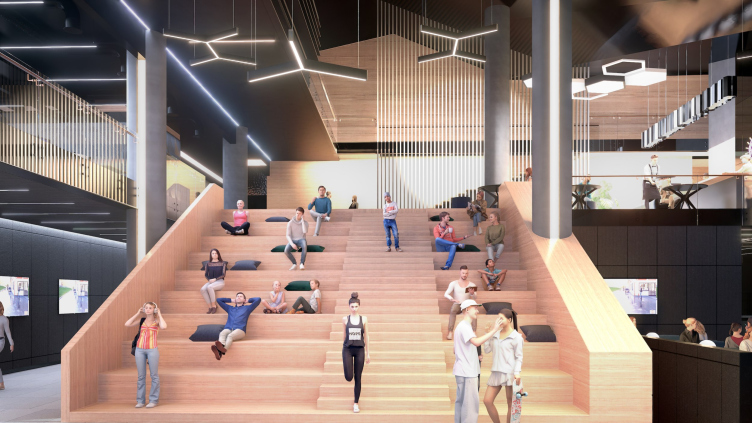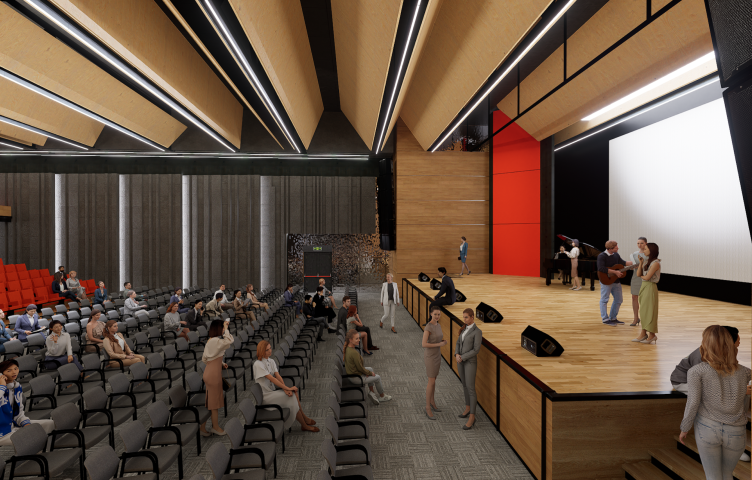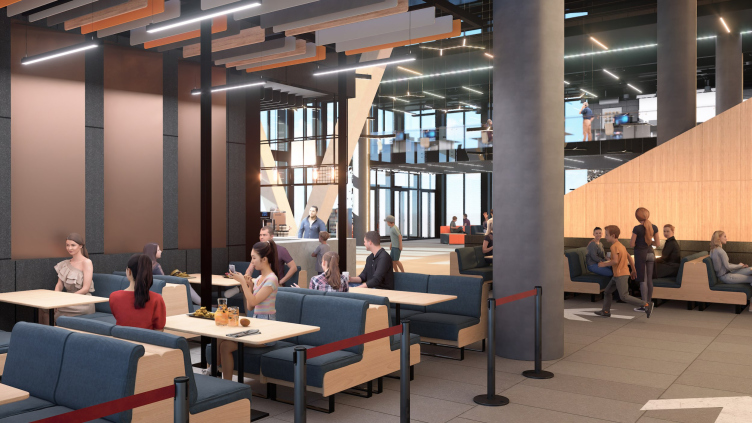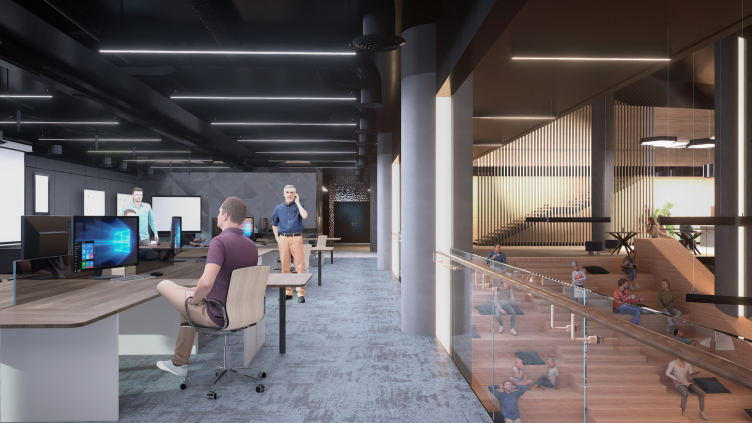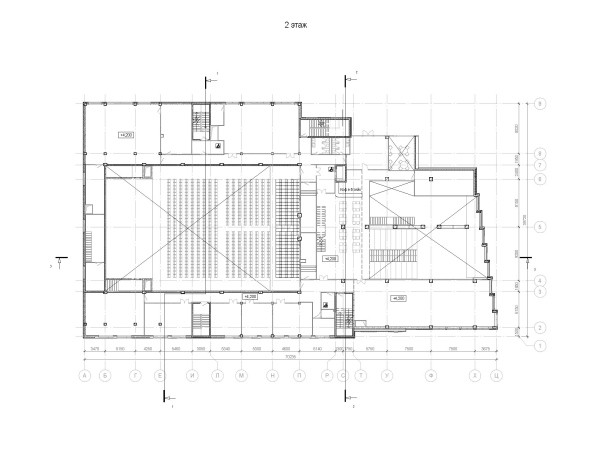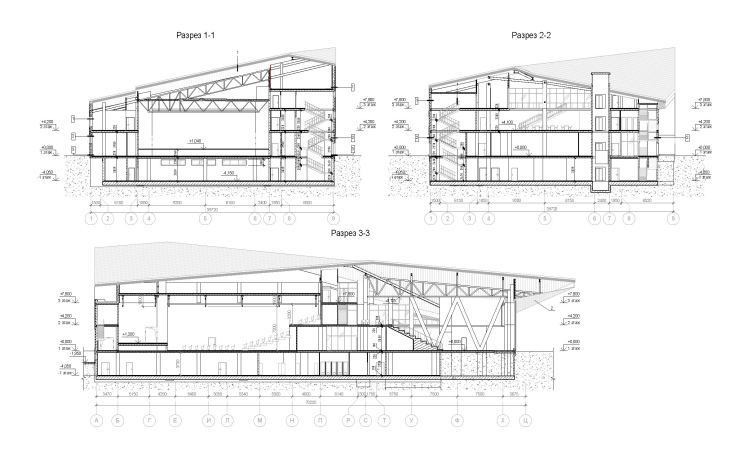Reconstruction of the regional youth center “Polyot” in Oryol
Copyright: © Mezonproject
Reconstruction of the regional youth center “Polyot” in Oryol – the angular view of the roof
Copyright: © Mezonproject
However, since the “Polyot” center is a significant and important object for the city, constant searches for a solution and discussions about breathing new life into it have been ongoing for the past ten years. The main problem, of course, was the lack of funds. Only in 2023 did hope arise, and the city administration managed to conduct a tender for the development of a reconstruction project, as a result of which “Mezonproject” landed the commission. In addition to the community center itself, the project envisages the development of the adjacent territory. The main pedestrian route passes through the elongated plot of land in front of the main entrance; to maintain intra-city connections and create an additional attraction, an open public area will be formed in front of and around the building.
Unfortunately, the deplorable current condition of the building did not allow for the preservation of it as a whole. “There are very beautiful steel roof structures there” explains the project architect Peter Topchiev “But somehow insulating them without hiding their main advantages (openwork and transparency) is impossible, so we developed the image of a unified hovering roof of the old building in a new quality, of course, providing at the same time for all measures to close the warm circuit”. As a result, only fragments of the old foundations will remain in the new “Polyot”. It is also known that behind the later-added cladding of the walls are mosaics from the Soviet era – these will be uncovered and an attempt will be made to transfer them to the new hall, if, of course, their quality and condition permit that.
Reconstruction of the regional youth center “Polyot” in Oryol – the amphitheater and the main facade
Copyright: © Mezonproject
Reconstruction of the regional youth center “Polyot” in Oryol – the side facade with a climbing wall
Copyright: © Mezonproject
Reconstruction of the regional youth center “Polyot” in Oryol – the facade development drawing
Copyright: © Mezonproject
Reconstruction of the regional youth center “Polyot” in Oryol – the facade development drawing
Copyright: © Mezonproject
At the same time, the new project undoubtedly seeks to preserve the spirit of the place, demonstrating clear continuity and respect for its predecessor. The architects themselves define the style in which it is executed as romantic futurism in a modern (I would also like to add “functionalist”) interpretation, which in itself is a reference to the architectural style of the late 1970s to early 1980s – the time of construction of the original building.
Reconstruction of the regional youth center “Polyot” in Oryol – the master plan
Copyright: © Mezonproject
The main element became the expressive roof, whose sharp corner marks the central entrance. A bold-looking cantilever with a significant projection pays homage to the canopy of the old building, at the same time visualizing the idea of flight. Similarly, the continuous glazed façade unmistakably reads as a reminder of a similar façade solution of the soon-to-be-gone center building. A square and public area with an amphitheater will be organized in front of the entrance, providing an opportunity for holding various outdoor events. Glazing is crucial for creating the effect of interpenetration of external and internal spaces. To further emphasize this, a public area will be created inside the lobby, mirroring the square, also featuring an amphitheater. The underside of the cantilever will further boost the intrigue of the building’s interaction with the surroundings: it will be covered with steel sheets, the texture of which imitates the surface of water. Similar sheets can also be found in the design of some of the internal areas.
Reconstruction of the regional youth center “Polyot” in Oryol – the foyer
Copyright: © Mezonproject
Reconstruction of the regional youth center “Polyot” in Oryol – the main hall
Copyright: © Mezonproject
The motif of angles and facets given by the roof further continues in the landscape design. “Polyot” is located deep within the block, so the long and narrow strip of urban territory leading to the entrance from Naugorsky Highway (this is where the entrance to the parking lot is located and the main pedestrian path begins) is very important for shaping the overall scenography and establishing close ties with the surroundings, especially since the sophisticated angular roof will be fully revealed in motion. At the beginning of this section, in its narrowest part, there is a gas distribution node, which cannot be moved and is difficult to disguise. Right in front of it, the architects proposed to arrange a small protected area for quiet relaxation. Further along, connected and simultaneously separated by a pedestrian path leading to the amphitheater, there will be Ping-Pong tables, trampolines, and a skate park. Special attention was paid to the ancient willow, which will by all means be preserved and will continue to serve as one of the gems of the entire landscape. The final elements of the active urban environment, which is being formed around the center, will be a climbing wall on the side façade and a fitness zone right across from it.
Reconstruction of the regional youth center “Polyot” in Oryol – the cafe
Copyright: © Mezonproject
Reconstruction of the regional youth center “Polyot” in Oryol – the coworking area
Copyright: © Mezonproject
As for the building itself, it will be clad in composite panels made of neutral gray aluminum. Metallic cladding will also be used in the interior, particularly in the rather dark areas, but in combination with light wood and bright furniture accents. The new building will have a very dense layout. A full underground floor will be added, housing a fitness center as well as sound recording and video editing studios. The concert hall, designed for 600 seats, will remain almost the same size as the old one, although the total area of the entire building will significantly increase and exceed 6000 square meters. Part of the front rows will be telescopic, in order to create a more flexible space that can be used not only for concerts of different genres but also for film screenings, meetings, lectures, and other events. On the sides of the hall and around the large atrium right in front of it, various functional zones will be located on three levels: cloakrooms and artistic rooms, center administration and youth department offices, cafes, co-working spaces, medical offices, a large two-story hall for choreography classes, a separate department for working with volunteers, and other facilities.
Orel really needs a youth center, as the city critically lacks such facilities. The Department of Youth Policy, which commissioned the project, and the management of the center itself, which continues to work and hopes for a new chapter in the life of “Polyot”, formulated all the functional requirements very clearly and in detail. Thanks to this, we were able to create an extremely compact layout and to accommodate quite different requirements within one volume. Now our main task together with technologists is to build clear working schemes of interaction between all functional zones. At the moment, the project is undergoing state expertise, and the city administration is actively looking for funds for its realization. I would like to believe that everything will work out.
The “Polyot” center does not have a status of the cultural heritage site. Nevertheless, the architects from “Mezonproject” have shown attention and respect for the memory of the city’s residents. Despite the absence of restrictions and the impossibility of preserving even individual fragments of the existing building, the new center should become its full-fledged successor. This aspiration is manifested not only in the functional program, materials, borrowing of 3D and 2D planning solutions, and the use of retrospective stylistic techniques, but also in how the new object establishes its relationship with the city.
Reconstruction of the regional youth center “Polyot” in Oryol – section views
Copyright: © Mezonproject

